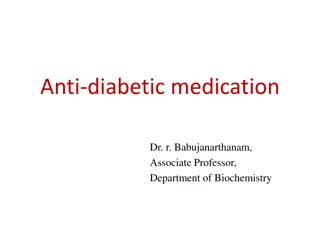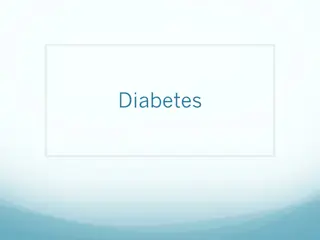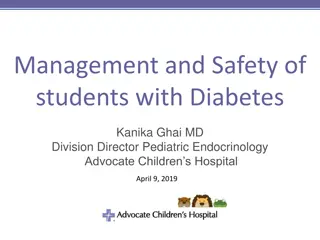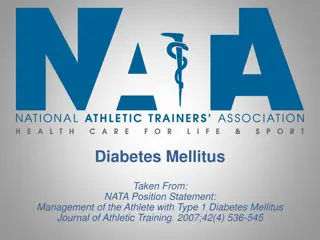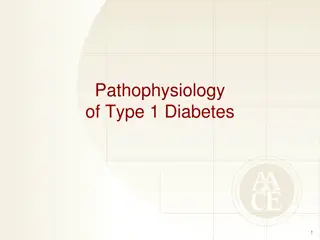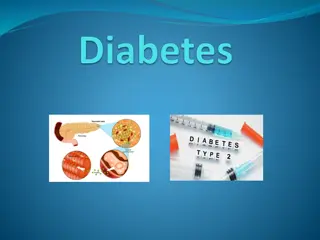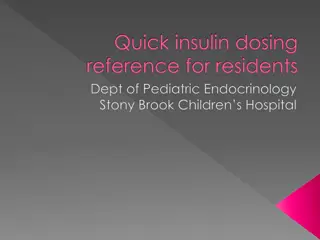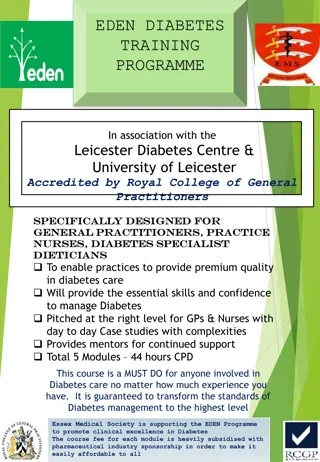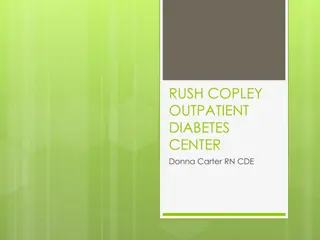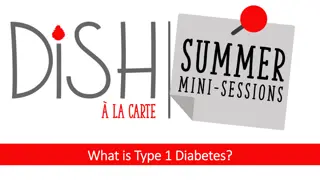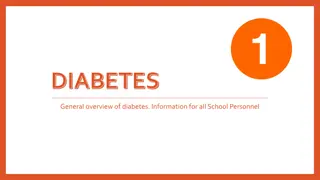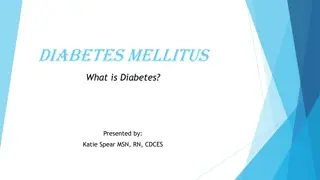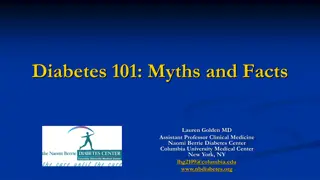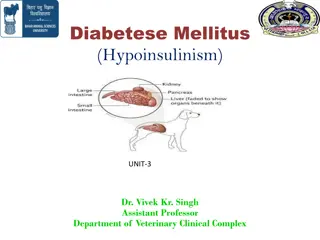Insights into Insulin Costs and Diabetes Management in 2019
Medical innovation has revolutionized diabetes treatment, providing advanced insulin options for better blood sugar control and reducing complications. Improved medication adherence among diabetes patients can lead to significant cost savings and enhance health outcomes. Despite declining prices for commonly used insulin classes after discounts and rebates, diabetes patients still face rising out-of-pocket costs due to increased coinsurance and deductibles in the commercial market over the past decade.
Download Presentation

Please find below an Image/Link to download the presentation.
The content on the website is provided AS IS for your information and personal use only. It may not be sold, licensed, or shared on other websites without obtaining consent from the author. Download presentation by click this link. If you encounter any issues during the download, it is possible that the publisher has removed the file from their server.
E N D
Presentation Transcript
Prescription Medicines: Insulin Costs in Context 2019
Prescription Medicines: Insulin Costs in Context www.phrma.org/insulin Medical innovation has transformed the lives of diabetes patients. A century ago, patients were treated with animal insulins. Today, patients have access to insulins that operate at the molecular level that more closely resemble insulin release as it naturally occurs in the body. More recent advances have driven much of this transformation. Maintenance of stable and consistent blood sugar levels is better than ever before, helping to avoid serious complications and reduced weight gain. Longer-acting insulins provide coverage for over 24 hours and enable greater flexibility in dosing and reduced risk of dangerous blood sugar drops. Rapid-acting insulins including an inhaled form enable dosing directly before or even after meals, rather than in anticipation of meals Insulin pens offer greater convenience, including some that reduce injections for high doses or ease use in children. *NOTE: Modern insulin treatment protocol often requires long-acting insulin to provide a base level of coverage all day along with meal-time administration of insulin to modulate spikes in blood glucose. 2
Prescription Medicines: Insulin Costs in Context www.phrma.org/insulin Better diabetes management saves money and improves health outcomes. Improving Medication Adherence Among Diabetes Patients Could: 22 Result in 1 millionless ER visits and hospitalizations annually million Americans live with uncontrolled diabetes. Save $8.3 billion for the U.S. health care system each year SOURCE: American Diabetes Association SOURCE: Jha, et al. Greater Adherence to Diabetes Drugs is Linked to Less Hospital Use and Could Save Nearly $5 Billion Annually. Health Affairs 3
Prescription Medicines: Insulin Costs in Context www.phrma.org/insulin After discounts and rebates, prices for the most commonly used insulin classes are declining. 70% 30% Amount prices after discounts and rebates have fallen in the last two years for long- acting insulins Net prices for long- acting insulins are less expensive now than in 2010 Amount discounts can lower the list price of insulin, according to industry analysts SOURCE: Bloomberg Businessweek, June 29, 2017; Bloomberg. June 29, 2016. SOURCES: SSR Health. US Brand Net Pricing Growth 0.2% in 3Q17, December 2017. Eli Lilly, Press Release, March 2019. SOURCE: SSR Health. US Rx net prices fall 4.8 percent y/y in 4Q18. March 18, 2019. 4
Prescription Medicines: Insulin Costs in Context www.phrma.org/insulin Diabetes patients face soaring out-of-pocket costs. Middlemen expose insulin patients to list prices through coinsurance or deductibles. Over the past 10 years in the commercial market: The share of patient out-of-pocket medicine spending represented by coinsurance has grown The share of patient out-of-pocket medicine spending represented by deductibles has grown 3x 2x Source: Kaiser Family Foundation, October 2016. 5
Prescription Medicines: Insulin Costs in Context www.phrma.org/insulin Insurers and PBMs have a lot of leverage to hold down medicine costs. Negotiating power is increasingly concentrated among fewer pharmacy benefit managers (PBMs). Insurers determine: FORMULARY if a medicine is covered 23% 24% TIER PLACEMENT patient cost sharing Top 3 Market Share: 76% ACCESSIBILITY utilization management through prior authorization or fail first 23% 30% PROVIDER INCENTIVES preferred treatment guidelines and pathways OptumRx (UnitedHealthGroup) CVS Health (Caremark) Express Scripts All Other Source: Drug Channels Institute, March 2019. 6
Prescription Medicines: Insulin Costs in Context www.phrma.org/insulin Negotiated savings are often not shared with patients. More than half of commercially insured patients out-of-pocket spending for brand medicines is based on the full list price Cost sharing for nearly 1 in 5 brand prescriptions is based on list price 29% 44% 55% 26% Copay Deductible Coinsurance Source: IQVIA. May 2018. 7
Prescription Medicines: Insulin Costs in Context www.phrma.org/insulin Sharing negotiated rebates would lower Medicare Part D patient costs. For a typical Part D patient with diabetes taking five medicines, including insulin: Out-of-pocket spending could decrease nearly $900 a year If we don t reform the rebate system, diabetes patients could pay twice what their insulin costs to their insurer when they are in the deductible. Premiums would only increase $3 to $6 a month, as little as a dime a day SOURCES: Avalere Analysis, 2019; OACT, Milliman and Wakely Analysis, February 2019. NOTE: Plan cost includes medical and pharmacy claims 8
Prescription Medicines: Insulin Costs in Context www.phrma.org/insulin Sharing negotiated rebates could save commercially insured patients as well. Example: High-Deductible Health Plan with a Copay Example: High-Deductible Health Plan with Coinsurance Mary has diabetes and spends $1,000 each year on medical and pharmacy expenses Kevin has diabetes and several other health conditions and spends $5,000 each year on medical and pharmacy expenses She would save $359 a year She would save about $800 a year Her premium would increase less than 1% Her premium would increase less than 1% Source: Milliman Analysis, October 2017. 9
Prescription Medicines: Insulin Costs in Context www.phrma.org/insulin Policy solutions to address insulin affordability challenges. FINALIZE PROPOSED RULE TO REFORM REBATE SYSTEM IN MEDICARE PART D Replace the current system of rebates in Part D with a system where discounts are passed directly on to patients at the pharmacy counter DELINK SUPPLY CHAIN PAYMENTS FROM THE LIST PRICE OF A MEDICINE Advance reforms that prevent PBMs and other supply chain entities from having their compensation calculated as a percent of the list price of a medicine and instead based on a fee based on the value their services provide ENSURE PATIENTS WITH STATE-REGULATED INSURANCE ALSO DIRECTLY BENEFIT FROM REBATES Support legislation at the state-level that would reduce patients out-of-pocket costs by sharing discounts and rebates with patients at the pharmacy counter SUPPORT FIRST DOLLAR COVERAGE OF INSULIN FOR HIGH-DEDUCTIBLE HEALTH PLAN PATIENTS Clarify Department of Treasury rules to make sure high-deductible health plans must provide coverage of insulin and other chronic disease medicines prior to the deductible COUNT THIRD-PARTY DISCOUNT PLANS TOWARD DEDUCTIBLES Change private health insurance rules to require health plans to count the cost of prescriptions purchased through third-party programs, like Blink Health and GoodRx, toward patient maximum out-of-pocket limits SUPPORT FLAT COPAYS FOR INSULIN FOR PATIENTS RECEIVING COST-SHARING SUBSIDIES IN THE EXCHANGES Make regulatory changes to ensure plans put at least one of each type of insulin on a copay-only tier 10


















































